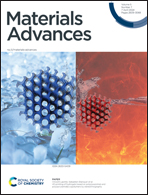Composite lithium conducting solid electrolytes based on zwitterionic plastic crystals and polymer nanoparticles†
Abstract
Organic ionic plastic crystals (OIPCs) are promising materials for the development of solid-state electrolytes for next-generation energy storage devices with improved safety. Zwitterionic plastic crystals, in which the cationic and anionic groups are covalently bound, are a promising alternative to traditional OIPC-based electrolytes as they offer a route to higher target ion transport by reducing the number of competing ions. Incorporating polymeric nanoparticles (NPs) into OIPC matrixes can create solid-state electrolytes with increased mechanical stability and enhanced ionic conductivity, but this has never been investigated for the plastic zwitterion-based electrolytes. In this work, we designed self-standing, conductive zwitterionic-based composite materials by combining lithium functionalised polymer nanoparticles with a zwitterion. The further addition of either lithium salt or solvent can be used to optimise conductivity and/or transference number of the solid electrolyte. The novel composite electrolytes prepared via this strategy offer a promising new pathway for the development of conductive and safe electrolytes for all solid-state lithium metal batteries.

- This article is part of the themed collection: Celebrating International Women’s day 2025: Women in Materials Science


 Please wait while we load your content...
Please wait while we load your content...